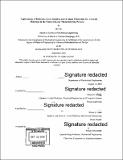| dc.contributor.advisor | Duane S. Boning. | en_US |
| dc.contributor.author | He, Han, M. Eng Massachusetts Institute of Technology | en_US |
| dc.contributor.other | Massachusetts Institute of Technology. Department of Mechanical Engineering. | en_US |
| dc.date.accessioned | 2019-02-05T16:00:49Z | |
| dc.date.available | 2019-02-05T16:00:49Z | |
| dc.date.copyright | 2018 | en_US |
| dc.date.issued | 2018 | en_US |
| dc.identifier.uri | http://hdl.handle.net/1721.1/120246 | |
| dc.description | Thesis: M. Eng. in Advanced Manufacturing and Design, Massachusetts Institute of Technology, Department of Mechanical Engineering, 2018. | en_US |
| dc.description | Cataloged from PDF version of thesis. | en_US |
| dc.description | Includes bibliographical references (pages 68-69). | en_US |
| dc.description.abstract | Early and accurate anomaly detection plays a key role in reducing costs and improving benefits, especially for complicated and time-consuming manufacturing such as semiconductor production. A case study of detecting anomalies from several monitored parameters during one plasma etching process is presented in this thesis. The thesis focuses on optimized ways to build reference cycles, or centroids of univariate parameters, a critical component to determine clustering accuracy and to facilitate process engineers' offline anomaly detections and diagnoses. Three time series centroid building methods are discussed and evaluated in the thesis, arithmetic, the Dynamic Time Warping Barycenter Averaging (DBA), and the soft-DTW-based centroid. As a result, DBA is chosen considering its comprehensive performance of accuracy and calculation time. Optimizations on DBA is further discussed to reduce calculation time. The window constraint, as well as the recalculation method of combining the previous centroid and new datasets, substantially reduce calculation time with slight accuracy loss. Based upon one centroid building method, shape extraction, a novel clustering method, k-shape, is implemented and applied to the plasma etching process. It is found that it achieves great accuracy with substantially shorter calculation time than one mainstream clustering method, k-means. | en_US |
| dc.description.statementofresponsibility | by Han He. | en_US |
| dc.format.extent | 76 pages | en_US |
| dc.language.iso | eng | en_US |
| dc.publisher | Massachusetts Institute of Technology | en_US |
| dc.rights | MIT theses are protected by copyright. They may be viewed, downloaded, or printed from this source but further reproduction or distribution in any format is prohibited without written permission. | en_US |
| dc.rights.uri | http://dspace.mit.edu/handle/1721.1/7582 | en_US |
| dc.subject | Mechanical Engineering. | en_US |
| dc.title | Applications of reference cycle building and K-shape clustering for anomaly detection in the semiconductor manufacturing process | en_US |
| dc.type | Thesis | en_US |
| dc.description.degree | M. Eng. in Advanced Manufacturing and Design | en_US |
| dc.contributor.department | Massachusetts Institute of Technology. Department of Mechanical Engineering | |
| dc.identifier.oclc | 1083130560 | en_US |
